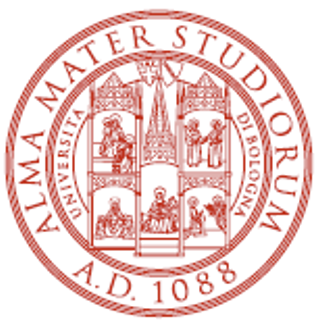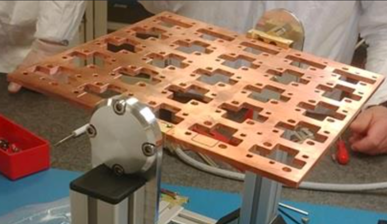The Bologna team activities take place mainly in the PhotoElectronics group, which has the task of creating the photosensors, starting from the SiPM then the PDM and finally the PDU (see here). DarkSide-20k will consist of 8200 PDMs and, to ensure a total system reliability, every part of it must be tested under operating conditions.
Electronic board test - LabVIEW and Cryo-Lab test
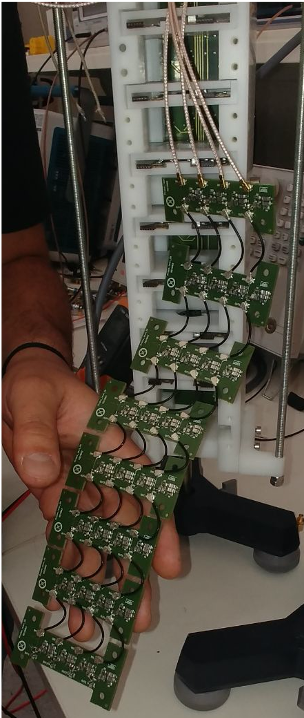
Each PDM integrates a Front End Board (FEB) for the amplification and conditioning of the SiPM signals. The Bologna group is responsible of the development of the test protocol (both hardware and software) of all the FEBs.
The test procedure is automated and allows to test 8 FEBs in each testing system at the same time. The current drawing, the bandwidth and the electric noise are measured and stored in the construction/test Database. A custom software developed in the LabVIEW enviroment automatically controls the measurement devices (power supply, oscilloscope, vector network analyzer...) . The software is responsible of the data taking and the DB upload too. The test procedure consists in a preliminary phase at room temperature and a set of cryogenic tests in liquid Nitrogen (77 K). In the first phase, all the possible faults of the device are diagnosed and a first set of measurements is taken. The tests in the latter phase, are the most important ones because mimic the liquid Argon temperature (87 K) as in DarkSide-20k.
SiPM detector Test
 The Bologna team is also involved on characterizing the new SiPM technology, NUV-HD-Cryo, developed for the Darkside project, in collaboration with FBK. These detectors have been tested both in the laboratories of the University of Princeton (New Jersey, U.S.A) and at the LNGS (L'Aquila, Italy) (both at room and cryogenic temperatures) and partially at the INFN laboratories, Bologna. The delicate connection between the sensor and the PDM tile on which the 24 SiPMs will be assembled has also been studied, including the analysis of the mechanical strength of the tile once the 24 SiPMs have been assembled together.
The Bologna team is also involved on characterizing the new SiPM technology, NUV-HD-Cryo, developed for the Darkside project, in collaboration with FBK. These detectors have been tested both in the laboratories of the University of Princeton (New Jersey, U.S.A) and at the LNGS (L'Aquila, Italy) (both at room and cryogenic temperatures) and partially at the INFN laboratories, Bologna. The delicate connection between the sensor and the PDM tile on which the 24 SiPMs will be assembled has also been studied, including the analysis of the mechanical strength of the tile once the 24 SiPMs have been assembled together.
Design and Construction
The Bologna section is also strongly involved in the design and construction of various components that will be used both for the two DarkSide prototypes (Proto-0 and Proto-1, see here) and for the final detector, DarkSide-20k. In particular, thanks to the INFN Bologna Design and Mechanical Workshop services, the group is involved in the construction of some mechanical components of the PDUs, such as the support structure in pure radio copper (Motherboard) and other mechanical components.
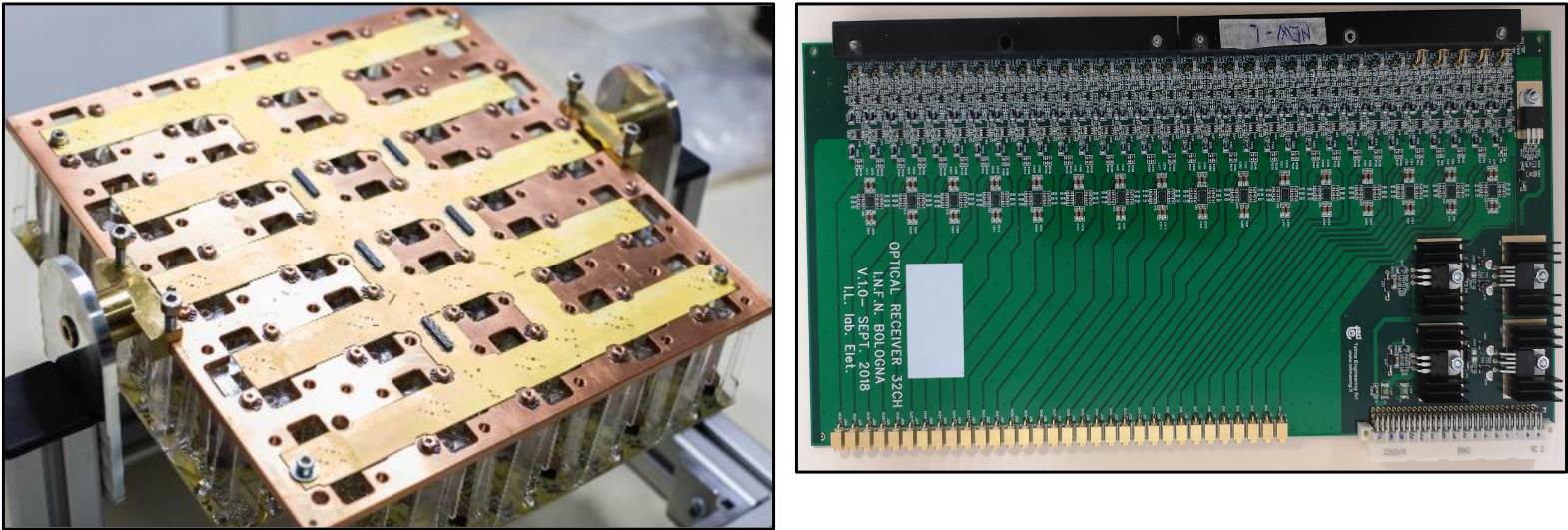 Other activities, in collaboration with the Electronics Service, are related to the development, design and testing of some components (operating at cryogenic temperatures, 87 K). In particular, Bologna contributed to the planning and design of the Finger Strips, flexible power supply and signal transmission lines for the PDUs, and of the Receiver card, which is used to receive the optical signals from the photo detectors and convert them into electrical signals.
Other activities, in collaboration with the Electronics Service, are related to the development, design and testing of some components (operating at cryogenic temperatures, 87 K). In particular, Bologna contributed to the planning and design of the Finger Strips, flexible power supply and signal transmission lines for the PDUs, and of the Receiver card, which is used to receive the optical signals from the photo detectors and convert them into electrical signals.
Assembly and Test in a Clean Room
The Bologna team is one of the PDM and PDU integration centers that will be used for the assembly of the photosensors both for the two DarkSide prototypes (Proto-0 and Proto-1, see here) and for the final detector, DarkSide-20k.

The integration of the photo sensors is carried out in a specially designed clean room that has been installed in 2019 in the INFN Bologna Section. The activity include the assembling of the Photo Detector Modules (PDM) consisting of the SiPM tile, the related front end card, Front End Board (FEB) and the mechanical support made of acrylic material (Plastic Cage). Each PDM is then inspected under a microscope to highlight any damage to silica or electrical contacts (Wire Bonding). Once assembled, 25 PDMs are then installed on the Motherboards (the copper support structures) so as to obtain the Photo Detection Unit (PDU). At the end of the assembly, functionality tests are carried out at room temperature (such as I-V curves).
Data acquisition: Proto - 0 and subsequent steps
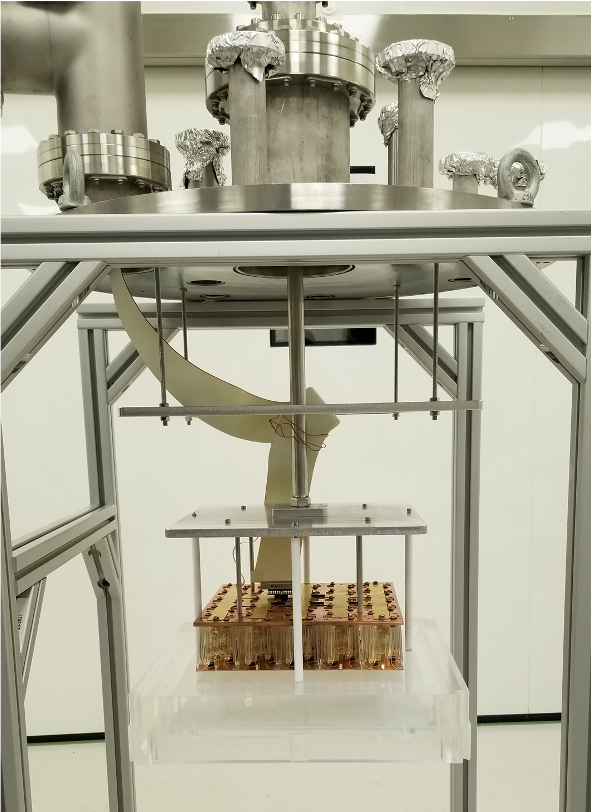
The first prototype of the DarkSide-20k, DS-Proto-0 has been built in 2019 thanks to various integration centres in Italy and then tested at CERN. The tests were carried out in two different phase each one devoted to the validation of one of the two PDUs of Proto-0. The Bologna group took part to both the phases, both during installation and during the run. The purpose of the preliminary tests was to verify the functionality of the first two PDUs produced, verify the mechanical components in an experimental setup and validate the assembly procedures and also for the development and optimization of data acquisition and analysis tools. Some preliminar results can be found here. Other tests will follow in 2020 to validate other electronic components such as the module that supplies the Bias voltage to the PDM (Steering Module) and later also the modules for signal transmission (optical transmitter and receiver).
The results of DS-Proto-0 will then be useful for the second prototype phase, DS-Proto-1.
Database
Masterclass
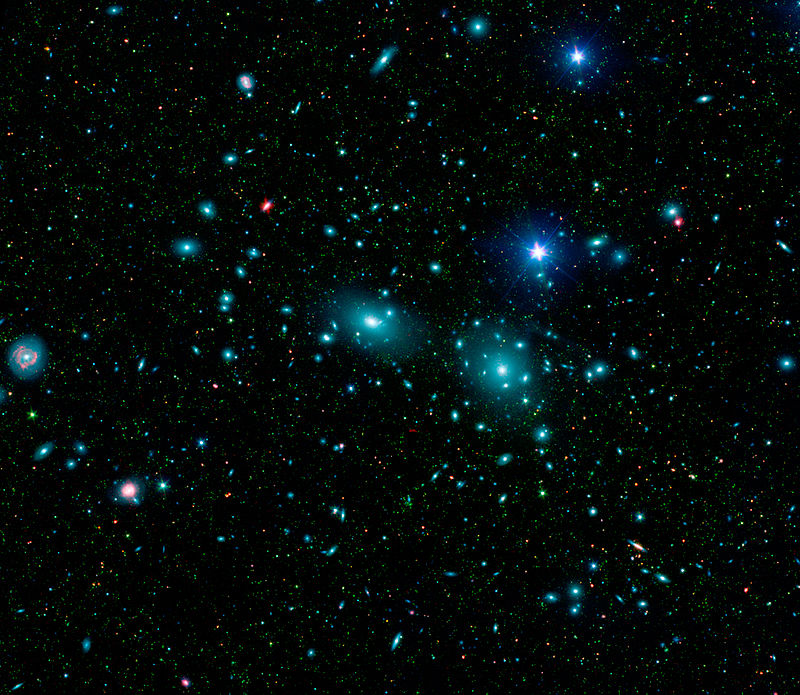
The Bologna group is also involved in Outreach activities. In particular, in collaboration with Centro Fermi (Rome), he created the first Masterclass of the DarkSide project. The idea of the Masterclasses was born from the IPPOG project, and wants to bring together high school students of different nationalities for a day to reveal the "mystery of particle physics", thanks to lessons held by researchers and activities made for students on purpose. Some event displays, including the working principle of the TPC, were made specifically for the realization of the Darkside Masterclass. At the official page you can find more details.
